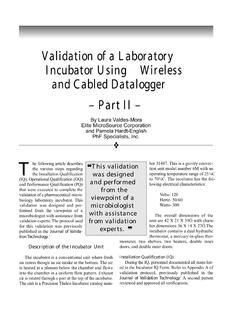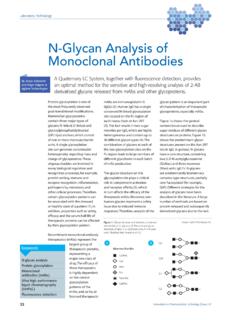Transcription of Current regulatory requirements for APIs - IPT Online
1 CHEMICAL TECHNOLOGY. Current regulatory requirements for apis The adoption of a global regulatory framework for active pharmaceutical ingredients ( apis ) can only be of benefit to the licensing authorities, the industry and - last but not least - the patient. Dr Chris Oldenhof, DSM/Gist-brocades A. ctive pharmaceutical ingredients ( apis ) are the US, EU and Japan participate, and by the start of the constituents which give medicinal the implementation of the Mutual Recognition products their pharmacological activity. Agreement (MRA), which was signed by the US and For this reason, the quality (and the consistency the EU at the end of 1998 (5). Both harmonisation thereof ) and the stability of apis are crucial factors and mutual recognition may well be the leading in the overall quality, safety and efficacy of principles with regard to regulatory developments medicinal products. This article highlights the worldwide in the years to come.
2 The US FDA very rapid developments which have recently taken Authorisation of medicinal products place and are still taking place in the area of system includes regulatory requirements for active pharmaceutical In many countries of the world, information worldwide ingredients ( apis ) in various parts of the world. relating to the API must be included in the These developments are translated into their registration document for the medicinal product inspections of Current and expected future impact on the market- itself. However, for registrations in the US, the EU. API place. Suggestions are given for regulatory API Member States and several other countries, such as manufacturers frameworks which will result in optimal benefits Australia, Canada and New Zealand, the for the licensing authorities, for industry and, last possibility exists for bulk manufacturers to file .. in contrast to but not least, for patients.
3 Separate dossiers for apis (and in the US, also for the Current The US Food and Drug Administration (FDA) API intermediates) with the authorities as European already for several decades has had an extensive and supporting information to the registrations of complex set of API requirements in place covering medicinal products. Such dossiers, which usually system, which the areas of Drug Registration (1) and Current contain detailed - and therefore confidential - today can still Good Manufacturing Practice (cGMP) (2) - and information on the manufacturing process, in be characterised new FDA regulations and guidelines are still most cases are called Drug Master Files (DMFs). continually being issued. Since about 1990, the For the older, off-patent apis , a specifically as a "paper authorities within Europe especially have also designed alternative system has been made tiger" acknowledged the importance of apis , as available through the European Pharmacopoeia.
4 Illustrated by a steep increase in the amount of This system, called Certification of Suitability , information on the manufacture and control of provides for the centralised assessment of API- apis to be included in Marketing Authorisation related information; the resulting Certificate applications within the EU (3). In addition, legal ( CEP ) may be used in Medicinal Product provisions are being developed by the European registrations in countries that are signatories to the Commission for the mandatory application of European Pharmacopoeia Convention. cGMP principles in API manufacture (4). The US FDA system includes worldwide Obviously, a basis is thus being laid for full inspections of API manufacturers, in order to harmonisation and/or mutual recognition of API ensure that the submitted documentation fully requirements for the US and EU markets in the represents the operational reality at the further future.
5 This is also illustrated by, for manufacturing site. This is in contrast to the example, the Current ICH (International Current European system, which today can still be Conference on Harmonisation) initiatives in which characterised as a paper tiger . 68 Innovations in Pharmaceutical Technology CHEMICAL TECHNOLOGY. Authorisation of changes in BACPAC (Bulk Actives Post Approval Changes). API manufacture initiative (6). It is the industry's hope that this new Guidance will lead to a resolution of this serious The US FDA procedures for the authorisation of flaw in the authorisation process. For countries changes in API manufacture, and to some extent accepting CEPs, authorisation problems of a also those which have recently been implemented similar nature occur less frequently. in the EU, require that authority approval for such changes should be obtained by the holder of the Current good manufacturing practice registration of the medicinal product.
6 This The US FDA requires by law that apis are regulatory principle has been found to result in manufactured under pharmaceutical cGMP. Its extreme hardship for, especially, the dedicated API worldwide inspection system enables it to verify and intermediates manufacturing industry and, in whether companies comply with these cGMP. particular, for the industry sector involved in the requirements . When serious cGMP deficiencies manufacture and supply of the older, mainstay are identified during such inspections, this may apis . Their numerous customers for each API result in the US borders being closed for apis from product will normally not be willing to go through that specific manufacturer. The EU is still in the often complex, tedious and expensive approval process of implementing legal requirements for processes. As a result, the implementation of - for cGMP to be applied to API manufacture.
7 The many reasons, often very necessary - changes has European Commission expects these requirements , frequently been blocked. plus a worldwide API inspection system, to be The FDA is in the process of revising its fully in place within three to four years from now, regulations and guidelines on bulk post-approval but many hurdles still need to be overcome to change authorisation procedures through its accomplish this. 70 Innovations in Pharmaceutical Technology CHEMICAL TECHNOLOGY. First of all, this is needed to protect the safety of the patient. Second, it is an absolute requirement for an ultimately successful MRA between the US. and the EU. And finally, this is needed to provide a level playing field for the API manufacturing industry, because it will ensure that all API. manufacturers will have to comply with the same rules and will thus have to make similar investments to accomplish this.
8 The API market under the future regulatory framework The global developments which have been set in motion in the regulatory and cGMP areas have now gained a momentum which allows us to visualise the standards we may expect to become a reality in the near and further future. The ICH initiative Q7a , aimed at defining a harmonised cGMP Guideline for API. manufacture, has reached a stage which indicates that a successful result will most probably be The API market under the Current reached (7). So we may expect a common, regulatory framework accepted cGMP standard for the US, the EU and The enormous differences which exist between the Japan to become effective by the year 2001. Thus, regulatory requirements in the various areas/ all API manufacturers wishing to (continue to). countries of the world imply that the supply their products for use in medicinal products standards to be met by API manufacturers will manufacture for these markets will have to comply differ widely, depending on the countries where with these high cGMP standards (8).
9 It may be the derived medicinal products will be marketed. expected that, in the longer term, the Q7a There are many Guidance will become the world standard. apis used in the manufacture of medicinal reasons for the products marketed in the US will have to meet all Based on this harmonised Guideline, and on EU to make of the FDA's regulatory and cGMP requirements , the soon to be amended EU Directive on apis as enforced through the FDA's inspection system. ( Starting Materials ), the EU will probably have haste with the fully implemented its worldwide API inspection This constitutes a significant cost factor for the implementation manufacturer. Producers of such apis are in system by the year 2002/2003. The of a solid addition still experiencing severe limitations to implementation process will be under continual wordwide improve their operations, due to the FDA's as yet time pressure from the US/EU MRA process, often insurmountably complex bulk post-approval which makes it improbable that serious delays will inspection procedures.
10 Full FDA regulatory compliance, occur. The inspection system will force all API. system therefore, intrinsically will imply seriously higher manufacturers supplying the EU market to API manufacturing costs. comply, not only with the high ICH cGMP. The regulatory standards with respect to the EU standards, but also with the submitted regulatory are today of a level similar to those of the FDA. information on API manufacture. Post-approval The same may be expected for cGMP change procedures will have to be carefully adhered to. requirements within several years. However, at this Massive differences still exist between the three moment, the lack of a means for the EU to verify ICH partners with respect to their requirements on compliance with the numerous EU regulations and the extensiveness of information on API. guidelines pertaining to submitted API manufacture to be included in regulatory information raises serious doubts as to whether all submissions.




